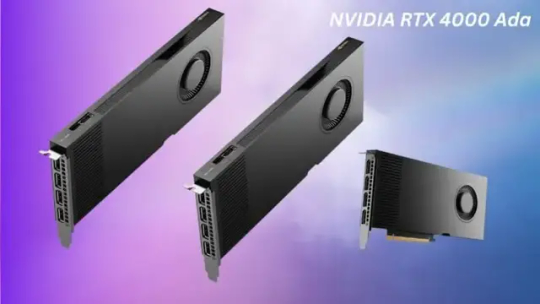#NVIDIARTX4000AdaGeneration
Explore tagged Tumblr posts
Text
NVIDIA RTX 4000 Ada Generation Price, Features And Specs

RTX 4000 Ada Gen
The NVIDIA RTX 4000 Ada Generation GPU was announced. It targets workstations and creative professionals that demand cost, performance, and efficiency. The NVIDIA RTX 4000 Ada Generation GPU, part of the Ada Lovelace-based RTX professional family, provides cutting-edge AI, ray-traced rendering, and hardware acceleration for scientific computing, video production, and 3D content creation and simulation.
Built with Ada Lovelace architecture
The NVIDIA RTX 4000 Ada Generation GPU and the latest consumer GeForce RTX 40 Series graphics cards use Ada Lovelace GPU architecture. This TSMC 4nm architecture boosts power efficiency and compute density for professionals with limited desktop space and electricity.
Important Ada architecture improvements include:
Fourth-generation tensor cores improve deep learning and AI.
Faster, more accurate ray tracing with third-generation RT Cores
Reordering Shader Execution (SER) optimises rendering pipelines
AV1 encoding and decoding is ideal for high-efficiency video streaming processes.
Key NVIDIA RTX 4000 Ada Generation GPU Features
20 GB ECC GDDR6 GPU Memory.
48 RT Cores.
192 TCs.
Interface: PCIe4.0.
130W TDP.
Small workstations benefit from the single slot.
Display outputs are 4x DisplayPort 1.4a.
Compact single-slot form factor is RTX 4000 Ada's main selling advantage. Offices and creative studios with limited desk or rack space benefit from GPU use in SFF professional PCs.
Read about AMD Radeon RX 6700 features, games, benchmarks, and pricing.
Efficiency and Performance
The NVIDIA RTX 4000 Ada Generation GPU outperforms the RTX A4000 in 3D rendering, photorealistic visualisation, and AI-enhanced content production. With under 130W power consumption, it offers unmatched professional GPU performance.
Independent reviewer benchmark testing demonstrates significant improvements in:
Blender and Autodesk Maya viewport rendering.
VR and Omniverse photorealistic rendering with real-time ray tracing.
PyTorch and TensorFlow workload AI model training and inference.
Good for Creative and Technical Workloads
The NVIDIA RTX 4000 Ada Generation GPU supports industry experts like:
Engineers and architects: Real-time design simulation and visualisation.
Media and entertainment artists include VFX, 3D animation, and 8K video editing.
AI researchers and developers: FP8-compatible deep learning frameworks.
Data scientists: Faster data processing and machine learning models.
NVIDIA's Studio Drivers and ISV certifications ensure excellent compatibility and stability with major professional applications from Adobe, Autodesk, Dassault Systèmes, and others.
Advanced AI and DLSS Support
Fourth-generation Tensor Cores in the RTX 4000 Ada enable DLSS 3 (Deep Learning Super Sampling), however this is more beneficial for simulation tools and real-time rendering than for gaming.
Tensor Cores improve AI workflow training and inference workloads by supporting FP8 accuracy. Topaz Video Enhance AI and Adobe Sensei help multimedia makers work faster.
Advantages
At 130W TDP, it's one of the most energy-efficient professional GPUs.
The single-slot design fits easily in small workspaces.
ECC-enabled 20GB RAM ensures performance and stability throughout longer workloads.
Advance Rendering: Real-time route, ray, and DLSS capabilities.
Strong AI Support: Tensor Core and FP8 acceleration promote ML/AI productivity.
Stable drivers: ISV certificates and NVIDIA Studio drivers are reliable.
Disadvantages
Despite its power, this device is for work, not play.
Supply may be limited due to a specialised market and high demand.
Absence of GDDR6X: GDDR6, however efficient, is slower than GDDR6X, which is on some consumer GPUs.
Even if it's cheaper than the RTX 5000 Ada, it's still expensive for casual users.
Conclusion
Professionals seeking the best rendering, AI, and compute capabilities in a small and effective package should consider the NVIDIA RTX 4000 Ada Generation GPU. Its Ada Lovelace architecture, better ray tracing and AI, and energy-efficient design make it ideal for workstations.
The NVIDIA RTX 4000 Ada Generation GPU can train machine learning models, create dramatic visual effects, and construct architectural models without overpowering your power supply or budget.
#NVIDIARTX4000AdaGeneration#NVIDIARTX4000#RTX4000Ada#NVIDIARTX4000AdaGenerationGPU#NVIDIARTX4000Ada#RTX4000#technology#technews#technologynews#news#govindhtech
0 notes